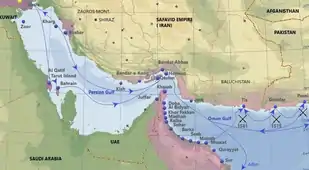| Action of 1 February 1625 | |||||||
|---|---|---|---|---|---|---|---|
| Part of Dutch–Portuguese War | |||||||
| |||||||
| Belligerents | |||||||
|
|
| ||||||
| Commanders and leaders | |||||||
|
| Unknown | ||||||
| Strength | |||||||
| 8 galleons | 8 ships | ||||||
| Casualties and losses | |||||||
| 262 killed | 29 killed | ||||||
The action of 1 February 1625 was a naval engagement between a Portuguese fleet and an allied Anglo-Dutch fleet, that took place on 1 to 24 February 1625 in the Persian Gulf. Although an allied tactical victory, with the Anglo-Dutch force inflicting several times their losses on the Portuguese, it resulted in a strategic Portuguese victory as they were able to regain the control of the Persian gulf.
Ships involved
Allies
- England:
- Eagle – 1 killed
- Royal James – 13 killed
- Jonas – 11 killed
- Star – 4 killed
- Netherlands:
- South Holland
- Bantam
- Maud of Dort
- Weasope
Portugal


Portuguese in the Persian Gulf and Red Sea; light green – territories and cities; dark green – Allies or under influence; yellow – main factories
- São Francisco 48 (Don Aliud Batellia) – 38 killed
- São Francisco 32 (Francisco Burge) – 31 killed
- São Sebastião 40 (António Teles de Meneses) – 20 killed
- São Salvador 22 – 41 killed
- Santiago 22 – 83 killed,
- Trindade 24 (Alva Botelia) – 24 killed
- Santo António 22 – 22 killed, sank later
- Misericórdia 22 (Samuel Rodriguez Chava) – 3 killed
- galleys
References
This article is issued from Wikipedia. The text is licensed under Creative Commons - Attribution - Sharealike. Additional terms may apply for the media files.